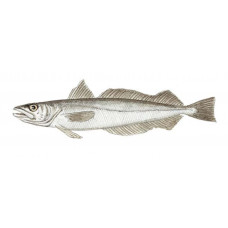Latin name
Merluccius bilinearis
Other names
Atlantic hake, whiting, frostfish; French: merlu argenté; Spanish: merluza norte-americana.
Identification
The body is long and slender, with a flattened head, a large mouth, and strong, sharp teeth. The mouth is terminal, with large jaws armed with large, sharp, inward-curved teeth, arranged in a single row on the upper jaw. On the lower jaw, in two rows or more. The lower jaw usually protrudes slightly forward relative to the upper. The length of the upper jaw is 1.8-2.0 times the length of the head, snout - 2.8-3.2 times, the space between the eyes - 3.4-4.2 times. Dorsal fins are two: the first is short, taller, triangular-shaped, the second is elongated, with a shallow notch at 1/3 of the fin end; anal fin similar in shape and height to the second dorsal fin; pectoral fins are elongated, slender; pelvic fins are slightly forward of pectoral fins: caudal fin truncated, with a weak notch. The lateral line is straight. Scales are relatively small. Gill stamens on the 1st gill arch thin, long. Body silvery or silvery-gray, darker on back; belly silvery-white. The front of the head dark blue or black-gray. Dorsal and anal fins transparent, but margins of dorsal fins often with dark border, and anal fins whitish; sinuses and ends of pectoral fins dark. The belly is dark with a reddish tint. Mouth cavity is black.
Distribution
It occurs from the coast of Newfoundland southward to the vicinity of South Carolina, and is found in large numbers between Cape Sable and New York City. Two stocks are identified in U.S. waters based on morphological differences: one extends from the Gulf of Maine to northern Georges Bank, and the other extends from southern Georges Bank to the Mid-Atlantic area.
Habitat
A near-bottom species. Occurs in a wide range of depths, with the depth of its distribution usually determined mainly by water temperature. Most often in the cool, deep waters of the continental shelf. Adults stay on the deep shelf, but make seasonal migrations between shore and sea. They live from the surface to depths of more than 600 feet. They prefer sand and gravel bottoms and temperatures ranging from 36° to 52 °F. The fish move to shallow waters in the spring, spawn, and return to their wintering grounds in the fall.
Size
The silver hake is characterized by a relatively rapid growth rate: by the end of the 1st year the fish have an average length of 20 cm, by the end of the 2nd - 28 cm and by the end of the 3rd - 33 cm, Three-year-old females are usually 28-44 cm long. Can reach 21⁄2 feet in length and weigh 8 pounds, with an average catch of less than 14 inches. Fish weighing more than 4 pounds are rare. Ages up to 15 years have been reported.
Life history and Behavior
Spawning occurs in the late spring and the early summer, when whiting release their buoyant eggs at the surface, allowing them to drift with the current. Future stocks depend on the weather; if the wind blows the eggs away from inshore, very few will survive, having nothing to feed on. Peak spawning occurs earlier in the southern stock (May and June) than in the northern stock (July and August). Important spawning areas include the coastal region of the Gulf of Maine from Cape Cod to Grand Manan Island, southern and southeastern Georges Bank, and southern New England south of Martha’s Vineyard.
Food and feeding habits
Silver hake is a predator that feeds mainly on other fish, such as representatives of cod, as well as many pelagic species: Atlantic herring, grinding herring, myctophids, smelt, atherins, mackerel, sand lance, butterfish and others. Juveniles feed on crustaceans, including euphausiids, and juveniles of other fish. In turn, silver hake serves as food for many predatory fish, primarily such as cod, pollack, swordfish, and some shark species. It is known that during the peak of feeding activity after spawning, they go to the shoals and shallow waters.
Reproduction
The fish mature at the age of two to three years. The spawning season lasts from May-June to September, with a peak in July and August. Caviar throwing portion, usually taking place at a temperature of 12-16°С. The released eggs have a diameter of 0.82-1.00 mm and remain in the pelagic zone for two to three days, after which they sink to the bottom.
| Classification | |
| Phylum | Chordata |
| Class | Actinopterygii |
| Squad | Gadiformes |
| Family | Merlucciidae |
| Genus | Merluccius |
| Species | M. bilinearis |
| Features | |
| Conservation status | Near Threatened |
| Habitat | Pelagic |
| Life span, years | 12 |
| Maximum body weight, kg | 2.3 |
| Maximum length, cm | 76 |
| Sailing speed, m/s | No information |
| Threat to people | Edible |
| Way of eating | predator |


